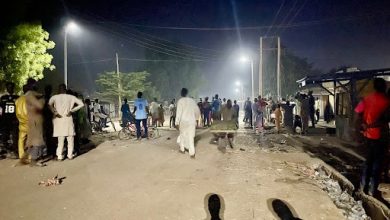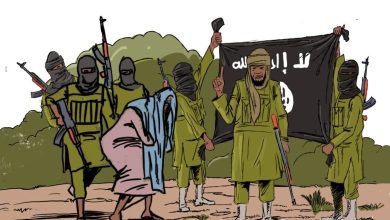Once Landowners, Farmers in North West Nigeria Now Toil on Terrorists’ Farms
From Zamfara to Kaduna, the intersecting crises of insecurity, food scarcity, and health decline reveal a region trapped in a vicious cycle.
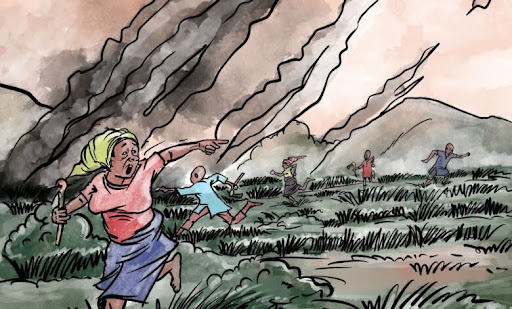
Isa Adamu’s voice carries both resignation and fury.
“Insecurity has really affected our agricultural productivity,” the 45-year-old farmer told HumAngle on the outskirts of Shinkafi in Zamfara State, North West Nigeria. “Food insecurity became the order of the day. Millet, sorghum, beans, cattle, all have disappeared before our eyes.”
He once harvested enough to feed his household and sell in nearby markets. Now, Isa must decide daily whether to risk his life, pay levies to terrorists, or abandon his farm altogether. He is one among millions across the region whose survival sits at the intersection of fear, hunger, and shattered health.
What began as an isolated rural unrest in Zamfara in 2011 has, experts say, metastasised into a full-blown national crisis, engulfing Kaduna, Sokoto, Kebbi, and the rest of the region that once fed much of Nigeria, and has since displaced more than 453,000 people in 2022 alone.
“Bad leadership, injustice, abject poverty and illiteracy are the root causes of [rural terrorism] here,” Deborah Ibrahim, a woman leader and resident of Juji, Kaduna State, told HumAngle. Rural councils, she added, are too impoverished to provide schools, clinics, or boreholes. The vacuum of state absence has been filled by armed non-state actors, men with guns, dictating terms.
The consequences are severe. Nearly three million people in the region are critically food insecure, a figure that, according to the Cadre Harmonisé report of the Food and Agriculture Organisation (FAO), rose to 4.3 million in the first quarter of 2025.
Rural terrorism, once the domain of a few outlaw gangs, has multiplied into loosely coordinated armed groups operating across Nigeria and into the neighbouring Niger Republic. Their activities have been devastating: murder, eviction and abduction of farmers; rustling of livestock worth billions of naira; torching of harvest-ready crops; and “levy” demands for the mere right to sow, reap, or live.
“Our farms have become their farms. We became labourers on land we once owned,” Muhammadi Dadi, a farmer in Zamfara, said.
In Sokoto, Isiyaka Dangaladima, the village head of Tsamaye, told HumAngle that for about four years now, farmers in four hamlets under his authority were forced to pay farming levy to an armed group’s leader known as “Yar Daribiyar”. Even after making the payments, they were not allowed to work their fields in peace; they were either killed or kidnapped for ransom.
“While working in their fields, armed groups often carried out sporadic raids for ransom kidnappings and, at times, brutal killings. I know of many farmers from the hamlets of Garsaku, Samgu, Malamawa, and Gidan Na Birni who were either kidnapped or killed while farming, even after paying the farming levy,” Isiyaka said. “Finally, they abandoned their farms altogether and sought refuge here in Tsamaye.”
Others tell similar stories. Jafar Shinkafi, a resident in the region, said his parents fled to Gusau out of fear even after they paid the levy.
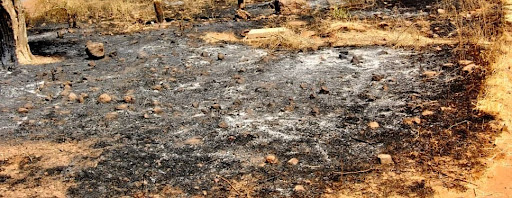
This forced appropriation of farmland by armed groups has transformed the terrorists into de facto landlords, with farmers enslaved as coerced labourers. Communities that once prided themselves on seasonal farming migration are now scattered not for opportunities but to escape death.
“I used to harvest 100 bags of sorghum from just one farm. Now, I cannot remember the last time I visited any of my 10 farms. They are simply too dangerous,” another farmer said.
“The phenomenon has not only claimed thousands of lives, but it has also forced migration of whole communities,” according to Muhammadi Dadi, a youth leader in Zamfara.
“Many residents have fled to Gwadabawa, Illela or Sokoto town, while those left behind live in fear of attacks”, Manu Bube, a farmer in Abdalo, a rural community in Sokoto, told HumAngle. Only a handful still risk going to their fields, and many have been killed in the process. Armed groups, he said, often collected planting and harvesting levies yet still blocked farmers from accessing their land. Fertile fields were abandoned, crops left unharvested, and households pushed into misery.
Families who risk farming face crushing debt. “Farmers here are being squeezed from both sides,” Isiyaka told HumAngle. “They cannot feed their families, and the loans they rely on only drag them deeper into hardship.”
Hauwa’u Maikasuwa, a farmer in Zamfara, described the trap: “Last year I took out a loan for fertiliser. After harvest, I had to borrow again to settle the first debt. My productivity keeps falling, and I continue to run at a loss because we work the fields in fear, never able to farm them properly.”
The most immediate consequence is hunger. But poverty, indebtedness, and displacement compound the misery. “It has been sheer mayhem,” Bube said. “Our lives and local economy have been destroyed.”

Several farmers and residents in the region who spoke to HumAngle said that the killings and kidnappings for ransom of farmers, abandoned fields, silenced markets and villages, have become their new reality.
Markets once thronged by buyers from across Nigeria and the Niger Republic now stand abandoned. Trucks used to come in and out of Zamfara’s Magami and Dangulbi markets have stopped altogether. “In the past, a small-scale dealer could run ₦3 million’s worth of stock. Today, many of us live in abject poverty without even seed money,” said one trader who asked not to be named.
In the North West, a good part of the supply chain has collapsed. Farmers can no longer freely access their fields, and when they do, yields are meagre, with crops sometimes abandoned after harvest. Rural farmers are often the first to be hit by famine. Traders no longer risk the highways, and consumers in distant cities face soaring food prices.
What should be seasonal food scarcity has become a permanent condition of want.
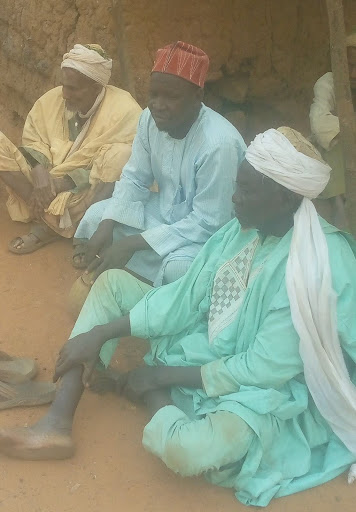
The silent casualty
The effects are not just empty fields and shuttered markets. The health consequences are stark. Malnutrition, anaemia, stunting in children, and rising maternal mortality are quietly trailing the violence.
Skeletal healthcare facilities in rural areas are already overwhelmed or abandoned. Where seasonal malaria and water-borne diseases were once the main challenges, entire communities now face trauma, starvation, and untreated injuries from terrorist attacks.
“Insecurity has reduced our earnings and incomes, but also led to poor health due to constant food insecurity and famines,” Ayuba Adamu, a farmer in Kaduna, told HumAngle.
For women, the situation is even more severe. Reports of sexual violence are widespread, with wives and daughters of farmers kidnapped, raped, or forced into marriages with armed groups. In some communities, women are compelled to engage in “sex for protection”, submitting to attackers to safeguard their families from further harm. Some undergo unsafe abortions to avoid bearing children for terrorists.
“Many of us had sex with these people in our rooms, some in open spaces, others were taken into the bush to ‘dance the tune’ for the whole day. After the incident, they all left us. This is heartless!” a woman in Zamfara told HumAngle in a previous interview.
Fragile resilience
Faced with the abdication of state responsibility, communities are improvising. Some succumb, paying levies or negotiating fragile “peace agreements” with terrorist groups. Others arm themselves, pooling meagre resources to purchase guns for local vigilante networks.
In Kebbi, communities have built networks with transport unions and fuel marketers to identify suspects. In Kaduna, farmers move to fields in groups, some standing guard from trees while others till the soil.
“Whenever we want to go to our farms, we go in groups of 15. Ten of us work on the fields, while five watch for armed groups,” said Jumi Adamu, a youth vigilante.
Yet these adaptations are fragile. Negotiated truces often collapse amid mistrust. Recently, residents of Adabka in Zamfara faced renewed attacks from terrorists barely three years after they crowdsourced and paid ₦20 million in a ransom-for-peace deal. One of those assaults left 16 people, including security operatives, dead.
In Kankara LGA in Katsina State, more than twenty villages and hamlets were forced to strike agreements with armed groups just to gain access to their farms, according to Abdulmajid Kankara, a local. Yet even after these deals, he said, the violence never stopped. In at least ten communities, including Zango, Babur, and Gurbi, the groups broke their promises, continuing to attack, kill, and abduct farmers for ransom while they worked their fields.
Isiyaku said that farmers in communities under the control of armed groups can no longer provide for their families. They pay heavily just to access their fields, yet risk being kidnapped while working. To secure their release, families often take out loans to pay ransoms; debts they struggle to repay after harvests that are never certain.
Outnumbered and underequipped
Local vigilantes, already overstretched and poorly armed, cannot match gunmen wielding assault rifles. Security personnel echo the same frustration. Their frustration is echoed by members of state-backed outfits such as Zamfara’s Community Protection Guards and Sokoto’s Community Guard Corps. In Katsina, the recruitment of 554 special constables for community policing has also failed to reassure residents. As one guard in Sokoto’s Tangaza LGA put it: “The state gave us toy guns compared to what the non-state armed groups have.”
This uneven presence and poor equipment feed perceptions of abandonment. “Here in Juji, we have soldiers protecting us. But in worse-hit places like Unguwan Yaban or Kasuwan Daji, there has been no deployment at all,” lamented Kaduna-based Deborah Ibrahim.
“Our inability to secure people and their farms lies in our challenge of inadequate manpower,” a police officer in Wamakko Division told HumAngle. “For instance, in the whole of this division, which I believe is one of the largest in terms of population in Sokoto State, we have less than 20 personnel.”
A retired Nigerian Army commander who once oversaw operations in the region described a similar imbalance: “Even with Operation Hadarin Daji, manpower was a very big challenge. I was overseeing about 5,000 soldiers, just the size of five battalions, and Zamfara alone could consume that. Armed groups would come on 200 motorcycles carrying three people each, that’s 600 men at once, sometimes better armed than us.”
“In those circumstances, we were fighting asymmetric warfare against enemies without uniforms or identity, often with informants embedded in the communities,” the commander, who asked not to be named, told HumAngle.
Soldiers and police face overwhelming odds, but poor welfare deepens their demoralisation.
“Police personnel are often reluctant to risk their lives and the future of their families,” a senior officer at the Wamakko Area Command told HumAngle. “Our retirement benefits and pensions are rarely paid on time, which discourages us all. Imagine officers leaving service at 65 or 70, after three or four decades, with no house of their own and no certainty of receiving their entitlements promptly. Faced with such realities, many of us feel powerless to confront heavily armed groups.”
Meanwhile, government-imposed mobile network shutdowns, intended to cut armed groups’ communications and vandalism of telecommunication facilities, have deepened the isolation of communities, preventing them from raising the alarm in times of attack. In June, HumAngle reported from Birnin Gwari in Kaduna State, where residents have not had good mobile coverage for over three years, one resident who sells telecom recharge cards described the experience as “we’re back to the Stone Age.”
“When we can’t reach the people we want to communicate with, we have to rely on word of mouth to get our messages delivered. It is that bad,” he added.
Breaking the cycle
Experts argue that military deployments alone cannot untangle the crisis gripping Nigeria’s North West. What is needed is a multi-layered response that goes beyond guns and checkpoints.
A security scholar at the Centre for Peace Studies, Usmanu Danfodiyo University, Sokoto, who spoke on condition of anonymity, outlined a way forward: governance reform to restore trust; fairness and service delivery in rural communities; agricultural support so farmers can reach their land and markets without extortion; livelihood diversification to ease overdependence on farming and herding; community engagement to mend fractured farmer-herder relations; and public health interventions to tackle malnutrition, trauma, and reproductive health needs.
Without such an integrated effort, the expert argued, the vicious cycle linking violence, hunger, and poor health will continue to devour the region, with destabilising consequences for Nigeria as a whole.
As the sun sets over Gusau, displaced farmer Isiyaka Ahmad Muhammad stares at the horizon where his farms once stretched.
“I used to harvest 100 bags each of millet, sorghum and maize. Now, hardly 20,” he said. “But I will not give up. Farming is who we are.”
It is this stubborn resilience, fragile yet unbroken, that keeps hope alive. But unless Nigeria recognises the full scope of the crisis and acts decisively, hope alone will not be enough to feed a starving people.
The farming community in North West Nigeria is grappling with severe insecurity caused by an escalation of rural terrorism that began in Zamfara in 2011. The crisis, driven by armed groups and compounded by bad governance, poverty, and lack of resources, has displaced over 453,000 people and left nearly three million critically food insecure, with a rise to 4.3 million projected by 2025. Farmers, forced to pay levies to armed groups, face eviction, kidnapping, and murder, which stifles agricultural productivity and traps them in cycles of debt and hunger.
Critical public health and economic infrastructures have deteriorated, with empty fields and abandoned markets highlighting the socio-economic collapse in the region. Communities attempt to combat insecurity with fragile peace negotiations and community vigilance, yet lack of adequate government support leaves them vulnerable. Military responses alone are insufficient; experts suggest comprehensive strategies involving governance reform, agricultural support, and community engagement are necessary to break this cycle of violence and impoverishment.
Support Our Journalism
There are millions of ordinary people affected by conflict in Africa whose stories are missing in the mainstream media. HumAngle is determined to tell those challenging and under-reported stories, hoping that the people impacted by these conflicts will find the safety and security they deserve.
To ensure that we continue to provide public service coverage, we have a small favour to ask you. We want you to be part of our journalistic endeavour by contributing a token to us.
Your donation will further promote a robust, free, and independent media.
Donate HereStay Closer To The Stories That Matter


